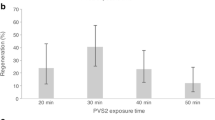Abstract
To cryopreserve sugar beet shoot tips using an encapsulation-dehydration technique, cold hardening of in vitro plants was needed to obtain high survival rates after freezing. Cold acclimation not only enhanced dehydration and freezing tolerance, but also induced several changes in sugar beet shoots. Plants contained greater amounts of sucrose, D-glucose and D-fructose and the fatty acid composition of lipids changed. Furthermore, the unsaturation level of membrane lipids, estimated by the (C18:2 + C18:1)/C16:0 ratio, increased after cold hardening. These changes were correlated with better survival rates after cryopreservation.
Similar content being viewed by others
References
Bertin P, Bullens P, Bouharmont J and Kinet JM (1998) Somaclonal variation and chilling tolerance improvement in rice: Changes in fatty acid composition. Plant Growth Regul 24: 31–41
Bulder HAM, van der Leij WR, van Hasselt PR and Kuiper PJC (1989) Interactions of drought and temperature stress on lipid and fatty acid composition of cucumber genotypes differing in growth response at suboptimal temperature. Physiol Plant 75: 362–368
Christie WW (1976) In Lipid Analysis. Oxford: Pergamon Press, p. 338
Crowe JH, Crowe LM, Carpenter JF, Rudolph AS, Aurell-Wistrom C, Spargo BJ and Anchordoguy TJ (1988) Interactions of sugars with membranes. Biochim Biophys Acta 947: 367–384
De Greef W and Jacobs M (1979) In vitro culture of the sugarbeet: Description of a cell line with high regeneration capacity. Plant Sci Lett 17: 55–61
Dereuddre J, Hassen N, Blandin S and Kaminski M (1991) Resistance of alginate-coated somatic embryos of carrot (Daucus carota L.) to desiccation and freezing in liquid nitrogen: 2. Thermal analysis. Cryo-Lett 12: 135–148
Fisher DB (1968) Protein staining of ribboned Epon sections for light microscopy. Histochemie 16: 92–96
Grout BWW (1987) Higher plants at freezing temperatures. In Grout BWW and Morris GJ (eds) The Effect of Low Temperatures on Biological Systems. London: Edward Arnold Ltd, pp 293–314
Hirch AG (1987) Vitrification in plants as a natural form of cryoprotection. Cryobiology 24: 214–228
Hughes MA and Dunn MA (1996) The molecular biology of plant acclimation to low temperature. J Exp Bot 47: 291–305
Kee SC and Nobel PS (1985) Fatty acid composition of chlorenchyma membrane fractions from three desert succulents grown at moderate and high temperatures. Biochim Biophys Acta 820: 100–106
Kendall EJ, Kartha KK, Qureshi JA and Chermak P (1993) Cryopreservation of immature spring wheat zygotic embryos using an abscisic acid pretreatment. Plant Cell Rep 12: 89–94
Koster KL (1991) Glass formation and desiccation tolerance in seeds. Plant Physiol 96: 302–304
Markhart AH, Peet MM, Sionit N and Kramer PJ (1980) Low temperature acclimation of root fatty acid composition, leaf water potential, gas exchange and growth of soybean seedlings. Plant Cell Environ 3: 435–441
McManus (1946) Histological demonstration of mucin after periodic acid treatment. Nature 158: 202
Moran R (1982) Formulae for determination of chlorophyllous pigments extracted with N,N-dimethylformamide. Plant Physiol 69: 1376–1381
Moran R and Porath D (1980) Chlorophyll determination in intact tissues using N,N-dimethylformamide. Plant Physiol 65: 478–479
Niino T and Sakai A (1992) Cryopreservation of alginate-coated in vitro-grown shoot tips of apple, pear and mulberry. Plant Sci 87: 199–206
Nishida I and Murata N (1996) Chilling sensitivity in plants and cyanobacteria: The crucial contribution of membrane lipids. Annu Rev Plant Physiol Plant Mol Biol 47: 541–568
Panis B, Totté N, Van Nimmen K, Withers LA and Swennen R (1996) Cryopreservation of banana (Musa spp.) meristem cultures after preculture on sucrose. Plant Sci 121: 95–106
Reed BM (1993) Responses to ABA and cold acclimation are genotypic dependent for cryopreserved blackberry and raspberry meristems. Cryobiology 30: 179–184
Rochester CP, Kjellbom P, Andersson B and Larsson C (1987) Lipid composition of plasma membranes isolated from lightgrown barley (Hordeum vulgare) leaves: Identification of 163 cerebroside as a major component. Archiv Biochim Biophys 255: 385–391
Scottez C, Chevreau E, Godard N, Arnaud Y, Duron M and Dereuddre J (1992) Cryopreservation of cold-acclimated shoot tips of pear in vitro cultures after encapsulation-dehydration. Cryobiology 29: 691–700
Vandenbussche B and De Proft M (1996) Cryopreservation of in vitro sugar beet shoot tips using the encapsulation-dehydration technique: Development of a basic protocol. Cryo-Lett 17: 137–140
Vandenbussche B and De Proft M (1998) Cryopreservation of in vitro sugar beet shoot tips using the encapsulation-dehydration technique: Influence of abscisic acid and cold acclimation. Plant Cell Rep 17: 791–793
Yahya A, Liljenberg C, Nilsson R, Lindberg S and Banas A (1995) Effects of pH and mineral nutrition supply on lipid composition and protein pattern of plasma membranes from sugar beet roots. J Plant Physiol 146: 81–87
Author information
Authors and Affiliations
Rights and permissions
About this article
Cite this article
Vandenbussche, B., Leurdian, S., Verdoodt, V. et al. Changes in sugar content and fatty acid composition of in vitro sugar beet shoots after cold acclimation: influence on survival after cryopreservation. Plant Growth Regulation 28, 157–163 (1999). https://doi.org/10.1023/A:1006262827160
Issue Date:
DOI: https://doi.org/10.1023/A:1006262827160




